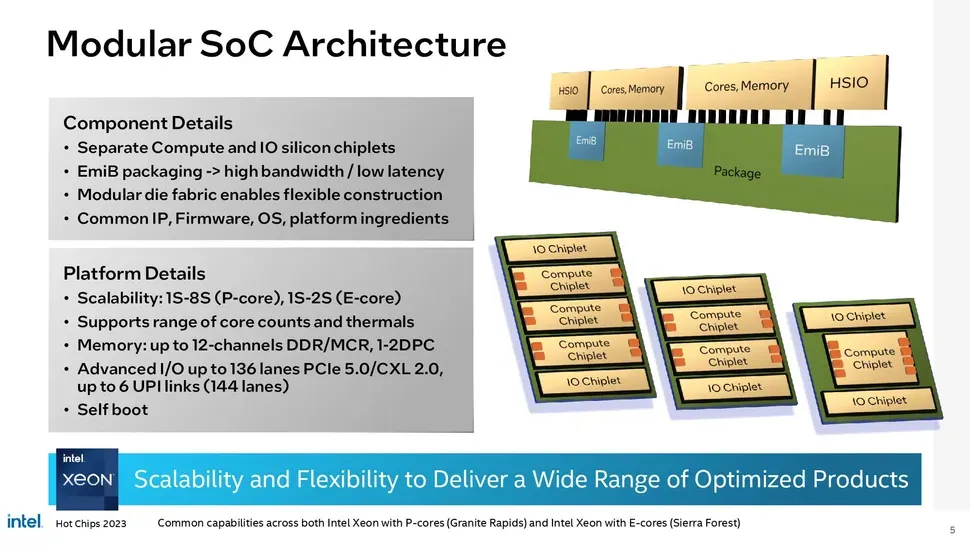
Intel has provided new details and specs on an upcoming refresh of its Xeon server CPU lineup. At the Hot Chips 2023 event, the comany revealed fresh details about its 144-core Xeon Sierra Forest and Granite Rapids processors.
The next generation of Xeon chips launches in H1, 2024, with a new tile-based architecture that features dual I/O chiplets on the 'Intel 7' process.
While the two platforms will share a common OS and firmware stack, each will target significantly different use cases.
(The chiplets will be paired with various configurations of compute cores built on the long-awaited 'Intel 3' process, allowing Intel to create a wide range of products whilst maintaining the same underlying modular configuration. Intel 3, previously known as 5nm, is the company's latest process technology.)

Intel said that the Sierra Forest like will mostly target lower-power and hi-density use cases such as cloud with a more energy efficient setup, while Granite Rapids will focus more on the high-performance markets and AI deployments.
The Sierra Forest chips will max out at two socket configurations, while Granite Rapids will scale up to eight socket support. Sierra Forest will be the first product fabbed on the Intel 3 process. As Tom's Hardware notes: "Intel initially moved to a tile-based (chiplet-esque) architecture with its fourth-gen Xeon Sapphire Rapids processors, but Sierra Forest and Granite Rapids bring a new level of disaggregation to the approach.
"Intel employed a four-die design with Sapphire Rapids, with each die containing a portion of the relevant I/O functions, like memory and PCIe controllers. The new processors fully disaggregate some I/O functions to two separate HSIO chiplets etched on the Intel 7 process, which offers the best balance of cost, power, and performance for I/O, while the CPU cores and memory controllers reside on their own dedicated compute chiplets."
"It is an exciting time for Intel and its Xeon roadmap," boasted Lisa Spelman, corporate VP and general manager for Xeon products and solutions.
"We recently shipped our millionth 4th Gen Xeon, our 5th Gen Xeon (code-named Emerald Rapids) will launch in Q4 2023 and our 2024 portfolio of data center products will prove to be a force in the industry."
The release marks a distinct split for Intel in how it targets the datacenter, giving the chipmaker two distinct lines for each of the energy-efficient and high-performance markets, even if the two processor lines will share mostly identical firmware and OS stacks.
In both cases, Intel says its upcoming generation of Xeons are being designed to offer the usual features of improved memory bandwidth and management as well as better I/O performance and capacity.
There are, however, key differences in where Intel has chosen to optimise and pitch each of its two lines.
For example, Intel notes that the Sierra Forest Xeons will over 2.5 times better rack density and 2.4 times better performance per watt over the previous lineup, while Granite Rapids chips will be equipped with "accelerators" aimed at improving AI performance.
The AI hardware market in particular has started to become more competitive for Intel, with companies such as Nvidia stepping up their game with a new generation of ARM-based "superchips" specifically designed for AI.
Currently, Sierra Forest is being planned to land in the second quarter of next year, while Granite Rapids set to ship "shortly" after.